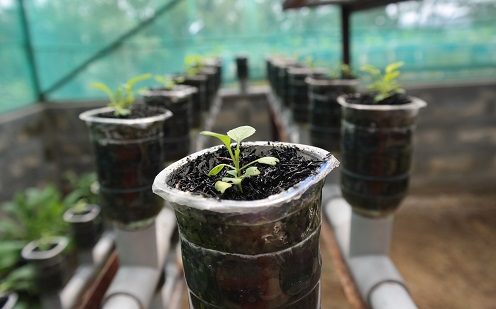VERTICAL FARMING
 Urban farming comprises cultivation methods and locations which often differ from our conventional perception of food production. Instead of exploiting our dwindling agricultural areas, many urban farming initiatives instead rely on indoor cultivation or vertical cultivation or use facilities originally designed for an entirely different context, e.g. rooftops and walls.
Urban farming comprises cultivation methods and locations which often differ from our conventional perception of food production. Instead of exploiting our dwindling agricultural areas, many urban farming initiatives instead rely on indoor cultivation or vertical cultivation or use facilities originally designed for an entirely different context, e.g. rooftops and walls.
These alternative cultivation practices require in-depth knowledge of plant growth requirements and conditions, in terms of which nutritional inputs are available, what kinds of plant protection can be implemented and how to safely extract and reuse wastewater from cultivation taking place under urban or peri-urban conditions.
Optimized cultivation through vertical production and artificial light
Whether we can succeed with alternative forms of cultivation in urban areas depends to a great extent on the demands consumers make regarding food and agricultural products. There will be some production systems, such as the cultivation of insects and leafy greens, where the advantages of production in intensive urban farming systems will be more apparent.
For alternative cultivation methods in urban farming to be relevant in an economic context, growers will need to know how to optimise cultivation under various unfamiliar conditions and elements. This applies, among others, to artificial light, hydroponic systems and vertical greenhouse production.
Experimental data and knowledge in this area exist, but more data is needed to establish the right framework for scaling urban farming initiatives so that they are economically profitable and provide a sufficient return on investment.
Would you like to get in touch with one of our urban farming experts?
- Nutrients for Higher organic crop Yields (NutHY) WP4: Agro-industry residues as nutrient resources
- Organic Food Systems Program: How to make food systems more sustainable?
- FoodSHIFT 2030
- Fertilization strategies in urban plant production systems
- Food quality in urban plant production systems
- Developing a more extensive database that will enable quicker advice on alternative production in urban area
- Identify relevant cases for the implementation of urban farming, including different technical scenarios, their budget and socio-economic profitability, and comparisons to other forms of production
- Mapping environmental effects of various urban food production system
- Mapping opportunities for utilising urban waste and resources in productio
- Experiments with cultivation using limited supplies of soil/water/light
Obtain knowledge of how we can produce food under urban conditions, for example indoors.
Learn how to supply nutrients to a rooftop farm or similar production system, and how to calculate the extent to which alternative cultivation systems may drive environmental and economic savings.
